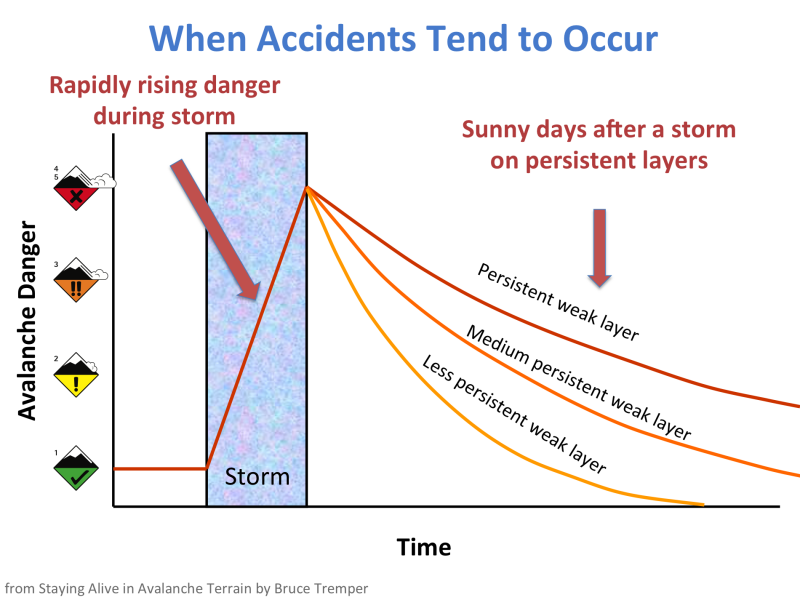
Utah Avalanche Center and the US Forest Service bring you the North American Public Avalanche Danger Scale.
You must remember four critical points about this scale:
1) The scale is not linear. Your risk increases about twofold for each rising level on the danger scale. In other words, you take on twice as much risk at Moderate as Low, and you take on four times more risk going from Low to Considerable. And so on. The risk numbers in the graph below come from Werner Munter’s estimates based on avalanche activity in Switzerland.
2) Most avalanche fatalities occur at “Considerable” danger because there is maximum interaction between people and avalanches. There is also more uncertainty associated with Considerable risk, and the difference between dangerous and not-so-dangerous terrain is much harder to identify.
Most people go into avalanche terrain in the middle danger ratings. Thus, avalanche fatalities tend to occur when there is a maximum interaction between avalanches and people.
3) The avalanche danger ratings are for “avalanche terrain,” meaning slopes steep enough to slide. In other words, slopes generally steeper than 30 degrees. But since 3 out of 4 avalanches occur on slopes between 34 and 45 degrees, the danger ratings are mainly for these slope angles. Even on High Danger days, you can always find safe terrain on low-angled slopes not locally connected to steeper slopes.

4) The danger ratings are based on BOTH probability and consequences. In the past, the danger ratings were based on the likelihood of triggering an avalanche. Still, the new danger ratings that came out in 2010 are based on the possibility of triggering (probability) versus size (consequences). This was adopted to conform to standard risk theory and as a better way to communicate the character of the hazard, for instance, avalanches that are hard to trigger, but if you do trigger one, it will be massive and dangerous.
Since avalanche danger depends on BOTH probability and consequences, different avalanche problems with the same danger rating can have very different characteristics. Some are high probability – low consequences. Some are low probability – high consequence. Some are in the middle. The avalanche problems listed here are typical of where we see them on a probability – consequence plot.

I’m sorry, but don’t they teach English to meteorologists and scientists? “..heightened avalanche conditions…” WTF?? write a non-profit gov’t grant to hire someone with communication skills, pls! You are part of the problem.
Wow! I prefer gentler critique when someone is trying to explain a highly technical and difficult to both calculate and understand set of concepts. Thank you, Utah Avalanche Center and USFS for helping me climb further into this.
I had quite a bit of confusion at first, sharpy. But over the last few years of reading avalanche assessments almost every day during season, I’m definitely climbing into the terminology (pun intended). I understand that every specialty has its own jargon which seems patently obvious to those who’ve learned, but is completely alien to people unfamiliar. The trick is to stick with it as the right neural nets get created behind each new concept. Sniping does not help either those in the know nor the rest of us. Thanks